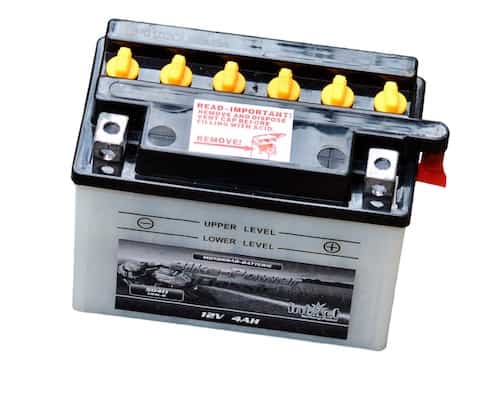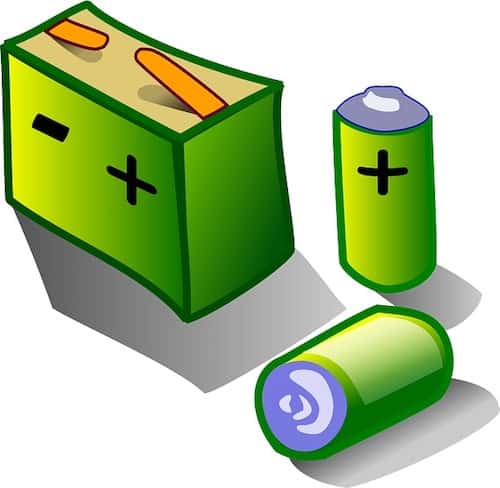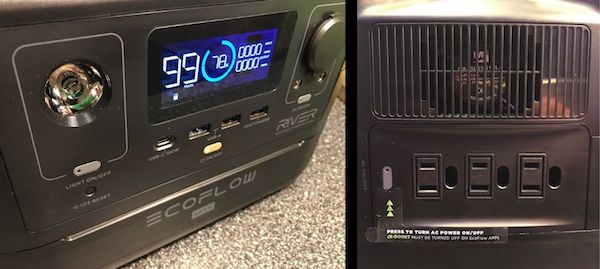When comparing a solar generator to a battery there are a few factors to consider. The first is utility and the second is cost.
A solar generator has a battery inside it and requires little setup to power electronics/appliances. A battery requires external components to bring power to whatever it is that you need to power. Because of this, solar generators are usually more expensive than a battery.
Using a battery (with a solar array set up) instead of a solar generator essentially means that you will either be creating a DIY solar generator or you’ll be installing a solar panel system throughout your RV or home. Installing a solar panel system can be a complicated process, however, creating a DIY solar generator is not as complicated due to its simple layout.
For individuals who are thinking of an alternative source of power, there is a bit of confusion when making choices with regard to this. This article is designed to give you all the information you need to cross this bridge if you are going that route.
What is the difference between a solar generator and a battery?


The difference between solar generators and batteries used with solar panels is that a solar generator has all the necessary components for self-sustaining power. In order for batteries to charge effectively from solar panels, a charge controller is used as an intermediary between the two.
All solar generators use batteries in order to store energy that may be needed off the grid. Batteries require proper charging and discharging in order to function properly, and solar generators meet this requirement because they each contain a Battery Management System (BMS).
A BMS monitors a battery’s charging/discharging status and communicates with other components within a solar generator in order to keep its battery in good shape.
A battery can only store energy when used with solar panels. A solar generator has multiple components that make it easy to recharge and discharge its battery, including a charge controller, inverter, BMS, and input/output ports.
Similar: What Is Battery Capacity & How Do I Measure It? (mAh/Wh/Ah/V)
Solar Batteries for Power Supply: How Exactly Do They Work?
Basically, everyone knows that batteries are used to store an electric charge capable of powering electrical gadgets. The uniqueness of solar batteries comes from the fact that they need to be accompanied by other equipment to make them function normally.
It is more like a solar PV system that needs solar panels, an inverter, equipment to mount the panels on your roof, and a performance monitoring system that tracks electricity production.
Basically, the solar panels collect energy from the sun in the form of photons and turn them into electricity. The acquired electricity is then passed through the inverter for conversion from direct current (DC) to alternating current (AC) and converted into a form that you can use to power your home.
How Is Solar Energy Stored in Batteries?

Solar batteries work by storing energy produced by your solar panels for later use. In some cases, solar batteries have their own inverter and offer integrated energy conversion. The higher your battery’s capacity, the more solar energy it can store.
In major parts of the world where solar panels are being used at scale to generate electricity, the panels are connected to the electricity distribution grid so that excess charge from the panels can be utilized by the population.
This sounds more like giving away an asset because you can’t preserve it. What if there was a way to store this excess charge and use it later when there is no electricity supply from the solar panel? That is why a solar battery is important.
If your solar panels are producing more electricity than you need, the excess energy goes towards charging the battery instead of going out to the grid. Therefore, you might want to consider getting a battery backup if you have a solar panel system installed on your roof.
That way, you can:
- Make use of the energy you stored earlier in your battery at night when your solar panels aren’t producing electricity.
- Use the battery or batteries as a backup power supply if a power outage were to occur.
I recommend looking into hybrid inverters as they can be used for charging batteries as well as sending power back to the grid from solar panels. You can find more information on these inverters and other backup power systems in my article here: Do You Need A Generator With Solar Panels? (Plus Alternatives).
To this end, it is crucial that you get a solar energy expert to calculate the amount of power being supplied by the solar panel system installed in your house. This will inform your decision on the type of battery you will need in terms of storage capacity.
Alternatively, you can do the calculation yourself if you understand the concepts of watts, watt-hours, amps, volts, and how the solar panel system works. If you don’t, it is advised that you seek the services of professionals in the solar panel industry to do the calculation and analysis for you.
Can Batteries Be Useful Without a Functioning Solar Panel and Inverter?

While batteries are typically paired with home solar energy systems, they can also be useful to homeowners without solar panels. Most batteries used with solar panels can also be powered with electricity from the grid to provide backup power. Therefore, you can also get a battery and have it charged up for later use.
This is fitting if you stay in an area characterized by an unpredictable power supply. You can always fall back on your battery for power usage in the event of a power outage.
If you have a solar panel system available and you have your battery connected to it, you can actually save money on power usage if you decide to buy a battery. However, this is a function of the way that your utility compensates you for your solar power.
Most power supply services offer total metering, meaning that you will receive a credit on your electric bill for every kilowatt-hour of electricity your solar panels produce. This means you won’t see additional savings on your monthly electricity bill if you install a solar battery.
Advantages of Batteries
- They are relatively cheaper to purchase especially when you have all the other components needed to make them function.
- They can help cut down on your electricity bill.
- They can be used for backup power during a power outage.
Disadvantages of Batteries
- They’re typically not portable unless you have a mobility cart.
- They require additional components to work as an off-grid power source.
- A solar installer is needed in most cases to properly connect your battery system.
The Build of Solar Generators on a General Note

Solar generators are generators that make use of solar energy as a fuel in the production and supply of power to gadgets. They are unique in that they are a pack containing all the components needed for them to function all in one power pack.
This includes the solar panels, inverter, AC outlets, and the battery. The battery is just a component of a solar generator. You won’t get to see it because everything is packed together and housed in the pack labeled as a solar generator. Is the battery’s activity in a solar generator any different from the battery used exclusively for power storage?
What Does the Battery Do in a Solar Generator?
The battery in a solar generator is designed to conserve energy so that it is available when you need to use it. A solar panel is an unreliable energy generation source. Therefore, the energy generated needs to be stabilized before use. Batteries assist in doing this in connection with the inverter. What exactly does the solar inverter do?
The Role of an Inverter in Making a Solar Generator Work

Usually, the electricity that is produced by the solar panel is not suitable for usage directly. Therefore, it is produced and stored as a direct current.
The solar generator is configured so that the battery takes in the direct current. Then, when it is time to be used, the charge goes through the inverter, which converts it to alternating current.
Usually, inverters in a solar generator are pure sine wave inverters. Apart from the conversion exercise that they do, inverters are also in charge of stepping up the voltage from 12V, 24V, or 48V to the required voltage of either 110V or 240V.
Advantages of Solar Generators
- With a proper transfer switch installed, they can help you store excess energy from your solar array instead of transferring it to the power grid.
- They are an all-in-one system that doesn’t require additional wiring or components.
- You have a power supply that works completely off the grid.
- Several types of solar generators can easily be moved around – most large models come with wheels.
Disadvantages of Solar Generators
- They are relatively expensive. This is only expected considering the fact that they are a combination of a battery and other accompanying components required to make them function properly.
- Integrating your solar generator with your home can be complicated.
- Solar generators are limited in their output capabilities, whereas a DIY setup can have a much higher output wattage ceiling.
Similar: Are Portable Solar Generators Too Expensive?
Solar Generator vs. Battery – Which Has a Greater Lifespan?

This is quite a sensitive point of consideration concerning these two powering options. There is no straightforward answer to the question; however, there are a few determinants of the lifespan of batteries and power generators.
Usually, whenever a solar generator or battery is manufactured, the manufacturing company indicates the number of cycles it is designed to go.
This simply refers to the number of times it is going to get fully charged up and go down to zero before its efficiency begins to drop. For example, Energy Apex’s battery has 2000 lifecycles.
This is a significant factor on which the lifespan of a solar generator and a battery depends. Remember, however, that solar generators have all their components in one package. In a sense, this enhances their life cycle.
There is a high possibility of combining a battery with an inverter that is not its right fit. Most likely, situations like this deplete the battery life cycle and make it lose efficiency faster than the manufacturer actually designed it.
It is also important to note that solar generators and batteries come in different sizes and carrying capacity (in terms of the amount of power they are designed to put out). However, it looks like a battery will start depleting earlier than a solar generator of the same capacity. This is obviously because it is more prone to the wrong combination of components required for it to function.
Similar: Gas vs Solar Generators – Which Makes More Sense?
Are Solar Generators a Better Option Compared to a Battery?
Solar generators seem to be the most flexible means of harnessing power from the sun.
When you think of the flexibility that comes from using solar generator models from top brands such as the Anker Powerhouse 200, Goal Zero Yeti 400 Lithium, Rockpals 500, and many more, with a little bit of research, you will definitely agree with the fact that these are some of the best solar generators needed to have an awesome camping experience.
You definitely cannot compare the experience with what you will have if you decide to make use of a battery. However, it is important to note that you will have to spend extra if you are going to be going for a solar generator in the place of a battery. The spending is justified by the benefits of its usage.
Conclusion
Solar generators are an all-in-one piece of equipment. In simpler terms, this means that they have the battery, inverter, LCD screen, solar panel inputs, and other outlets within the generator’s construction.
On the other hand, a battery, such as an AGM battery or lithium battery needs several other items to be useful to the person using it.
Also, using a battery instead of a solar generator means that there are several more steps needed to make the battery into a useful DIY solar generator. The use of a battery is way more complicated as it will mean that you have to connect separate working parts.
The use of solar batteries seems less expensive when compared to the cost of purchasing a solar generator. One good thing about the choice of the solar generator is that you can always use it for outdoor events if the need for it arises.
You can’t do that easily for a solar battery because it has too many separate components that could get damaged if not correctly handled while moving them around. Whatever the case may be, it is up to you to make a choice of what fits your personal needs, be it a solar generator or a solar battery.
Continue Reading:
Top 15 Best Solar Generators for Camping (Small to Large)
